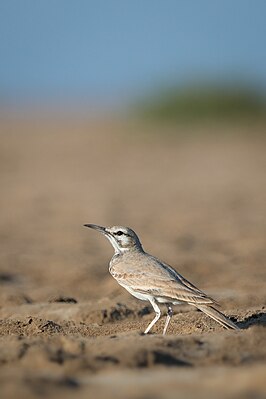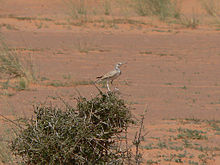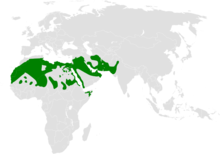Sandpiper lark
| Sandpiper lark | ||||||||||||
|---|---|---|---|---|---|---|---|---|---|---|---|---|

Sandpiper Lark ( Alaemon alaudipes ) |
||||||||||||
| Systematics | ||||||||||||
|
||||||||||||
| Scientific name | ||||||||||||
| Alaemon alaudipes | ||||||||||||
| ( Desfontaines , 1789) |
The sandpiper lark ( Alaemon alaudipes ) is a species of bird in the lark family (Alaudidae) that inhabits sandy deserts and semi-deserts. Their distribution area extends from the Cape Verde Islands , through the Sahara , the Middle East to western India . The rather large species of lark is notable for its black and white wing pattern, with which it is reminiscent of a hoopoe in flight . The memorable, whistling song is performed in a singing flight, in which the bird rises up to 5 m high with its tail spread apart and falls to the ground in a swoop.
description
The sandpiper lark is about as tall as a star at 19–23 cm , but very slender and long-legged with a 3–3.5 cm long, pointed and slightly bent beak. The wings are wide and rounded and the species is reminiscent of a hoopoe due to the black and white wing pattern in flight, which is also referred to by the English name Greater Hoopoe-lark . The tail is relatively long. The rear toe is 6.2–8.6 mm for a lark and is quite short and slightly bent down. The genders do not differ externally. At 39–51 g, the male is heavier than the female, which weighs between 30 and 47 g. In addition to the normal, there is a less common gray morph and intermediate stages also occur.
Adult birds are sand-colored to beige-brown on top with gray areas on the forehead, center of the head, neck and sides of the head. The over-eye stripe is cream-colored, the long eye-stripe and the beard stripe are black. The beak is dark gray, the iris dark brown. The breast is cream-colored with black spots, the rest of the underside is cream-white. The wings are black with a white base, the inner ones also have white tips. The white arm wings show in the middle a wide black band that runs across the wing. The control feathers are mostly blackish, but the middle ones are brown with light borders, the outer ones mostly white. The legs and feet are light gray.
In the youth dress the head pattern is less pronounced, the plumage on the upper side is lined with yellowish beige.
Geographic variation
The species varies in size and plumage. The Cape Verdean subspecies A. a. boavista is smaller, more brownish and darker than the nominate form. A. a. desertorum is about the same size, but grayer. A. a. doriae is also very gray and quite small, but larger in the west than in the east.
- A. a. boavistae Hartert , 1917 - Cape Verde Islands
- A. a. alaudipes ( Desfontaines , 1789) - Sahara and Middle East
- A. a. desertorum ( Stanley , 1814) - Red Sea coasts, central Arabian Peninsula
- A. a. doriae ( Salvadori , 1868) - Iraq and eastern Arabia to India
voice
The characteristic singing is performed in acrobatic singing flight and consists of a series of monotonous, somewhat melancholy whistling tones lasting about 12 seconds. It increases in speed as the bird climbs up. At the climax there is a short trill, then another, descending and slowing down row. A short, whirring siee or srriee can be heard as a contact call .
distribution
In Cape Verde, the sandpiper lark occurs on Boavista and Maio . In the Sahara, the distribution extends from southern Morocco south to Mauritania , in the north and center of Mali , in the center of Niger , in central and eastern Chad and in the north of Sudan . In the Middle East, the deposits extend eastward to Syria , Jordan and northern Saudi Arabia , across the coasts of the Red Sea southward to northwestern Somalia and in central Saudi Arabia to southern Yemen . The area then stretches eastward from Iraq and eastern Arabia to Pakistan before reaching its eastern border in the far northwest of India.
The species is mostly common and not threatened. In the interior of larger desert areas, however, the settlement density often drops sharply. In Israel the sandpiper lark is rare and in India it is only scattered. In Algeria and Chad there was a further spread - presumably due to increasing desertification .
Dispersions may occur in dry years . The species has been detected as an errant in the Canaries , Senegal , Italy , Malta , Greece , Turkey and Lebanon .
Way of life
The sandpiper lark inhabits deserts or semi-deserts with sandy soils and sparse vegetation in flat or hilly terrain. In Pakistan the species occurs up to an altitude of 2000 m. It also lives in gravel deserts with open sandy areas. It reaches high settlement densities in coastal Regs in North Africa with Nucularia bushes and small sand dunes. The height of vegetation in the habitats is quite variable. The presence of open, sandy areas seems to be important.
The diet consists mostly of invertebrates , occasionally small vertebrates such as small geckos or lizards . The focus of nutrition can vary from region to region, usually including beetle larvae , grasshoppers , termites , ant lions and snails. Most of the time the food is found up to 5 cm deep in the soft sand. Snails are thrown out of the air onto hard ground or hit against stones to break the shell. The species gets by without drinking water.
The sandpiper lark is territorial all year round. A district in Israel can be over 1 km². The singing flight of the male is quite spectacular. Usually from a control room it flutters and rises 2–5 m in height with spread control springs, then flips over, drops vertically and only brakes with its wings shortly before landing.
The breeding season varies depending on the geographical location and is linked to rainy seasons. In Cape Verde it is between October and March, in North Africa and Saudi Arabia between February and July and in August, in Pakistan and India between March and July or in September. There are one or two broods per season. The nest is built by the female and stands on low bushes or in tufts of grass, less often under the protection of plants or stones on the ground. Usually it is then set in with small stones. It consists of small twigs and is lined with soft material. The diameter of the nest hollow is 7–8 cm. The clutch consists of 2-4 eggs, which are incubated by the female or both partners for 14 days. The young leave the nest 12–13 days after hatching and stay with their parents for at least a month. The breeding success depends heavily on the intensity of the rainfall. In dry years, some pairs do not even start breeding, but in good rainy years the breeding success can be very high.
literature
- Eduardo de Juana, Francisco Suárez: Greater Hoopoe-lark (Alaemon alaudipes) (2004/2014), in: J. del Hoyo, A. Elliott, J. Sargatal, AD Christie, E. de Juana (eds.): Handbook of the Birds of the World Alive. Lynx Edicions, Barcelona 2014.
Web links
- xeno-canto: Sound recordings - Greater Hopoe-lark ( Alaemon alaudipes ) , accessed October 26, 2014.
- Alaemon alaudipes in the endangered Red List species the IUCN 2012. Posted by: BirdLife International, 2012. Accessed October 29, 2014.
- Sandpiper lark feathers



